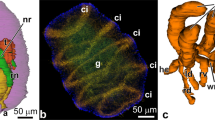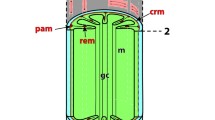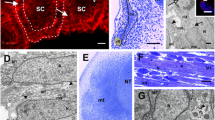Summary
In the mesogloea of the Ctenophore Pleurobrachia pileus a skeleton is developed built up by connective tissue laminae. These structures are in continuity with the subectodermal basement membrane and the walls of the organs. The laminae form a system of compartments into which thin lamellae or veil-like processes of the thicker membranes extend. Partly smaller funnel shaped compartments exist. Within the compartments the ground substance is localized which contains a feltwork of filaments. The basic elements of the laminae, their lamellar extensions and of spiral fibres occurring in the mesogloea are filaments of the same appearence. A periodical structure of these filaments has not been observed. The regular pattern of the compartmental organisation reflects the radial symmetry of the Ctenophore.
The surfaces of neighbouring laminae are connected by smooth muscle cells. Besides that myocytes are regularly enclosed into the interior of the laminae and the basement membranes. The skeleton in the mesogloea of Pleurobrachia is therefore characterized as ”muscle-membrane system“ in analogy to the musculo-elastic systems to be found in vertebrates.
The question whether the myocytes of the mesogloea are innervated or not, deserves further electron microscopical investigation.
Zusammenfassung
Die Mesogloea der Rippenqualle Pleurobrachia pileus enthält ein aus Bindegewebsmembranen (Laminae) bestehendes Skelett, das den Raum zwischen dem Ektoderm und der Wand der Hohlorgane einnimmt. Mit den subepithelialen Basalmembranen stehen die Laminae in kontinuierlichem Zusammenhang. Die Laminae umschließen ein System von Kammern, in die sie sich mit zarten Lamellen fortsetzen; letztere bilden stellenweise röhrenartige Formationen. In der Ordnung des Membransystems spiegelt sich die radiäre Organisation des Ctenophorenkörpers. In den Kammern der Mesogloea liegt gallertige Grundsubstanz, in die Filamente eingebettet sind. Gleichartige Filamente bilden das Baumaterial der gröberen Membranen und isolierbarer Spiralfasern, die durch die Mesogloea hindurchziehen.
Die Oberflächen der Laminae werden durch glatte Muskelzellen miteinander verbunden. Myozyten kommen ferner im Inneren der Membranen einschließlich der Basalmembranen regelmäßig vor. Das Mesogloeaskelett von Pleurobrachia wird deswegen — in Analogie zu den elastisch-muskulösen Systemen der Wirbeltiere — als muskulo-membranöses System bezeichnet.
Die Frage, ob die Myozyten der Mesogloea innerviert werden, ist offen.
Similar content being viewed by others
Literatur
Barnes, R. O.: Invertebrate zoology. Philadelphia-London: W. B. Saunders Comp. 1963.
Bullock, Th. H., Horridge, C. A.: Structure and function in the nervous systems of invertebrates I. San Francisco and London: H. Freeman & Comp. 1965.
Chapman, G.: Studies of the mesogloea of coelenterates. I. Quarterly J. microsc. Sci. 94, 3rd ser., 155–176 (1953).
Chun, C.: Die Ctenophoren des Golfs von Neapel und dem angrenzenden Meeresgebiet. Fauna und Flora des Golfs von Neapel, I. Leipzig 1880.
Davis, L. E., Haynes, I. E.: An ultrastructural examination of the mesogloea of Hydra. Z. Zellforsch. 92, 149–158 (1968).
Greve, W.: Zur Ökologie der Ctenophore Pleurobrachia pileus Fabr. Diss. Mathem.-Naturw. Fakultät der Universität Kiel. 1969.
Hyman, L. H.: The invertebrates: Protozoa through Ctenophora, vol. I. New York: Mc Graw-Hill 1940.
Korn, M.: Zum Nervensystem der Ctenophore Pleurobrachia pileus O. Müller. Zool. Anz. 163, 351–359 (1959).
Perkins, F. O., Ramsey, R. W., Street, S. F.: The ultrastructure of fishing tentacle muscle in the Jellyfish Chrysaora quinquecirrha. A Comparison of contracted and relaxed states. J. Ultrastruct. Res. 35, 431–450 (1971).
Samassa, P.: Zur Histologie der Ctenophoren. Arch. mikr. Anat. 40, 157–242 (1892).
Schneider, K. C.: Histologisches Praktikum der Tiere. Jena: G. Fischer 1908.
Siewing, R.: Lehrbuch der vergleichenden Entwicklungsgeschichte der Tiere. Hamburg und Berlin: P. Parey 1969.
Author information
Authors and Affiliations
Additional information
Herrn Prof. Dr. Vladeta Simič (Beograd) in kollegialer Verbundenheit gewidmet.
Durchgeführt mit dankenswerter Unterstützung durch die Deutsche Forschungsgemeinschaft und die Stiftung Volkswagenwerk. — Herrn Prof. Dr. O. Kinne, Direktor der Biologischen Anstalt Helgoland, danke ich für Überlassung eines Arbeitsplatzes, Herrn Dr. Wulf Greve (Helgoland) für die Bereitstellung von Untersuchungsgut, Fräulein K. Jacob und Frau A. Rast für geschickte technische Hilfe.
Rights and permissions
About this article
Cite this article
Bargmann, W. Zur Architektur der Mesogloea. Z.Zellforsch 123, 66–81 (1972). https://doi.org/10.1007/BF00337674
Received:
Issue Date:
DOI: https://doi.org/10.1007/BF00337674




